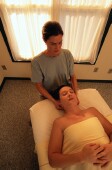
THURSDAY, Aug. 7, 2014 (HealthDay News) — Getting your neck adjusted by a chiropractor or osteopathic doctor may be associated with an increased risk of stroke, according to a scientific statement released Thursday by the American Heart Association.
The energetic thrusts and rotations sometimes used in neck manipulation may cause a small tear in the artery walls in the neck, a condition called cervical artery dissection, the statement noted.
A tear in the artery wall can result in a stroke if a blood clot forms at the site and later breaks free to block a blood vessel in the brain.
Such a tear “occurs with a sudden movement that can hyperextend or rotate the neck, such as one you may see with whiplash or sporting events, or even violent coughing or vomiting,” said statement author Dr. Jose Biller, chair of neurology at Loyola University Chicago Stritch School of Medicine. “The techniques for cervical manipulation, even though they vary among health professionals, include a rotation of the neck and sometimes a forceful thrust.”
These artery wall injuries are an important cause of stroke in young and middle-aged adults, accounting for 8 percent to 25 percent of stroke cases in patients younger than 45, the authors said in background information.
Four large studies have established an association between neck manipulation and stroke in patients 45 and younger, although the evidence does not prove that the practice can directly cause strokes, the paper stated.
Nonetheless, chiropractors and osteopathic physicians ought to warn patients of this link, the statement added.
“We strongly believe that patients should be informed of this association before undergoing neck manipulation,” Biller said.
The statement was published in the Aug. 7 online edition of the journal Stroke.
The chiropractic community is aware of the association between neck manipulation and stroke, which is an issue that has simmered for about five years now, said Keith Overland, immediate past president of the American Chiropractic Association and a doctor of chiropractic in Norwalk, Conn.
But Overland said that the evidence remains mixed and inconclusive.
“Two studies that have come out recently said that there is no evidence that the force or direction utilized in cervical manipulation reaches the threshold of stretching the arteries to the point that they can be damaged,” he said, adding that professionals who perform neck adjustments apply force that is “no greater than what people can do in activities of daily life.”
Overland added that neck manipulation is associated with many fewer stroke deaths than other common medical treatments for neck pain.
Neck manipulation is associated with about one death per 1 million people due to cervical artery dissection, he said.
By comparison, nonsteroidal anti-inflammatory drugs (NSAIDs) cause 153 stroke deaths per 1 million people, narcotic medications cause 53 stroke deaths per 1 million people, and spinal surgery of the neck causes 500 stroke deaths per 1 million people, Overland said.
“We are concerned that a statement like this can possibly create a fear in a patient, preventing them from making a choice of treatments that may in fact turn out to be the safest choice of all for their neck pain or headache,” he said.
In a statement released Thursday, the American Osteopathic Association had this to say about the new statement: “U.S.-trained osteopathic physicians [DOs] use osteopathic manipulative therapy to diagnose, treat and even prevent illness or injury. DOs are taught to conduct thorough evaluations using standard neurological and orthopedic examinations.”
The statement noted that osteopaths should not be grouped with chiropractors and physical therapists, who are not physicians and use different techniques for cervical manipulative therapy.
Biller noted that the association between neck adjustments and stroke is difficult to evaluate. People who already have suffered an artery tear may seek treatment to relieve neck pain, which is a common symptom of cervical artery dissection that can precede a stroke by several days.
Because of this, all medical professionals — including chiropractors and osteopaths — should be on the lookout for any stroke risk factors occurring in patients seeking help for neck pain or chronic headache, he said.
Overland agreed, adding that chiropractors should discuss the potential stroke risk of neck manipulation with any patient who has other risk factors for stroke, such as cardiovascular disease, family history of stroke or severe headaches.
By the same token, chiropractors shouldn’t necessarily discuss stroke risk with someone with no other risk factors, he added.
“If someone came in from playing basketball and they have a pulled muscle in their neck, but are otherwise perfectly healthy, we don’t see a relationship or risk there,” Overland said. “The discussion should be based on a thorough examination.”
More information
Visit the U.S. National Library of Medicine for more on neck pain.
Copyright © 2024 HealthDay. All rights reserved.

